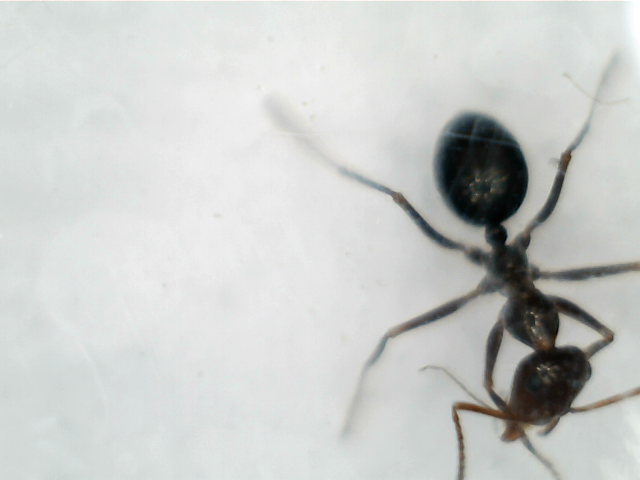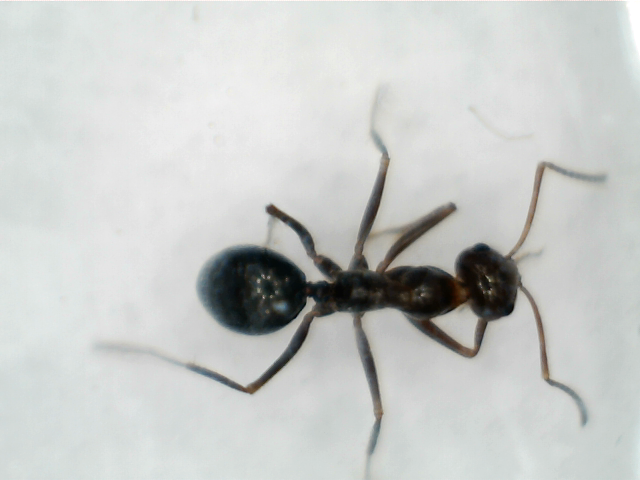I went out with kellakk today to try and find another Pheidole queen. No luck, but found these guys along a trail not far from a few Pogonomyrmex nests. My best guess is Camponotus. Any other ideas?




Best Answer dspdrew , February 5 2015 - 7:41 AM
There are some Camponotus with thorax shape like this, but they live on other continents and do not have such extravagant palps.
Oh wow. I thought that was a rule. Next you're not going to tell us that some Myrmecocystus have really small maxillary palps are you? ![]()

I went out with kellakk today to try and find another Pheidole queen. No luck, but found these guys along a trail not far from a few Pogonomyrmex nests. My best guess is Camponotus. Any other ideas?


Camponotus vicinus, Crematogaster 1, Crematogaster 2, Formica francoeuri, *, *, Myrmecocystus testaceus, Novomessor cockerelli, Pheidole hyatti, Pogonomyrmex californicus, Pogonomyrmex rugosus, Solenopsis invicta
Kinda looks like Myrmecocystus.
The easiest way to tell some of the common medium sized formicines from Camponotus, is looking at the thorax. Camponotus will always have one large hump. This ant has two humps, therefor it's something other than Camponotus. What color is this ant, because it's silhouetting pretty bad on that white background, so I don't think we're seeing the color very well? Also, how long is it in mm? I think Greg's probably right. I'm beginning to like that area more and more.
Edited by Foogoo, February 1 2015 - 12:22 AM.
Camponotus vicinus, Crematogaster 1, Crematogaster 2, Formica francoeuri, *, *, Myrmecocystus testaceus, Novomessor cockerelli, Pheidole hyatti, Pogonomyrmex californicus, Pogonomyrmex rugosus, Solenopsis invicta
Myrmecocystus come in a lot of colors. Did they look anything like this?

What about Dorymyrmex? This nest was 1-2 m away from a Pogonomyrmex nest.
Current Species:
Camponotus fragilis
Novomessor cockerelli
Pogonomyrmex montanus
Pogonomyrmex rugosus
Manica bradleyi
Not Dorymyrmex. That's a dolichoderine, not a formicine like your specimen. This looks strongly like Myrmecocystus.
Edited by Miles, February 1 2015 - 10:59 AM.
PhD Student & NSF Graduate Research Fellow | University of Florida Dept. of Entomology & Nematology - Lucky Ant Lab
Founder & Director of The Ant Network. Ant keeper since 2009. Insect ecologist and science communicator. He/Him.
Myrmecocystus come in a lot of colors. Did they look anything like this?
Based on my ant identifications skills probably equal to that of a 3rd grader, I'd say yes. They looked like Camponotus (I've never seen Myrmecocystus, that I know of) - larger ants with slender bodies and long, spidery legs. They did not have the body/legs like Pogonomyrmex/Messor.
Camponotus vicinus, Crematogaster 1, Crematogaster 2, Formica francoeuri, *, *, Myrmecocystus testaceus, Novomessor cockerelli, Pheidole hyatti, Pogonomyrmex californicus, Pogonomyrmex rugosus, Solenopsis invicta
If this is Myrmecocystus I'd be very, very happy. Now I just need to sit next to it every day for the next 6 months ![]()
Current Species:
Camponotus fragilis
Novomessor cockerelli
Pogonomyrmex montanus
Pogonomyrmex rugosus
Manica bradleyi
If this is Myrmecocystus I'd be very, very happy. Now I just need to sit next to it every day for the next 6 months
99% sure this is Myrmecocystus. Go sit now. ![]()
PhD Student & NSF Graduate Research Fellow | University of Florida Dept. of Entomology & Nematology - Lucky Ant Lab
Founder & Director of The Ant Network. Ant keeper since 2009. Insect ecologist and science communicator. He/Him.
There's some better pictures of this colony in this thread.
Current Species:
Camponotus fragilis
Novomessor cockerelli
Pogonomyrmex montanus
Pogonomyrmex rugosus
Manica bradleyi
Myrmecocystus they are. ![]()
Can anyone define 'diurnal'?
Can anyone define 'diurnal'?
Diurnal, as in active during the day.
Current Species:
Camponotus fragilis
Novomessor cockerelli
Pogonomyrmex montanus
Pogonomyrmex rugosus
Manica bradleyi
Oh I see now.
No doubt it's a diurnal Myrmecocystus. Look at the length of that maxillary palp in the first image! There are some Camponotus with thorax shape like this, but they live on other continents and do not have such extravagant palps.
There are some Camponotus with thorax shape like this, but they live on other continents and do not have such extravagant palps.
Oh wow. I thought that was a rule. Next you're not going to tell us that some Myrmecocystus have really small maxillary palps are you? ![]()
0 members, 1 guests, 0 anonymous users